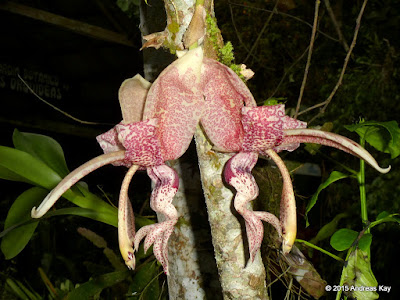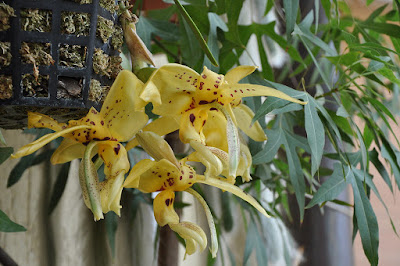Stanhopea orchid originate from Mexico to north-west Argentina in Central and South America. Its grows in damp forests at elevation from sea level to 5000 meters above sea level. This genus is named for the 4th Earl of Stanhope (Philip Henry Stanhope), president of the Medico-Botanical Society of London.
Stanhopea orchid also called as Ceratochilus, Stanhopeastrum, Gerlachia, Tadeastrum, is a genus of the Orchidaceae family. This genus was described by John Frost ex William Jackson Hooker in 1829.
IDENTIFY STANHOPEA ORCHID PLANT
Stanhopea orchid originate from Mexico to north-west Argentina in Central and South America. Its grows in damp forests at elevation from sea level to 5000 meters above sea level. This genus is named for the 4th Earl of Stanhope (Philip Henry Stanhope), president of the Medico-Botanical Society of London.
It is epiphytic, but occasionally terrestrial orchids with ovate pseudobulbs that carry a single long elliptical leaf. In nature, the areal roots of this genus often grow upwards building a nest. Here they collect leaves and dust, supplying the plants with nutrients.
Many Stanhopea flower in summer and some in autumn. They have highly fragrant short-lived flowers that last about 3-4 days and usually emerge through the bottom of the hanging basket in which they are growing, that's why they are sometimes called upside-down orchids. Flowers are often spicily fragrant, each plant may produce many inflorescences throughout the year.
STANHOPEA ORCHID PLANT CARE AND CULTURE
Cultural information should only be used as a guide, and should be to be adapted to suit you. Your physical location; where you grow your plants, how much time you have to devote to their care, and many other factors, will need to be taken into account. Only then can you decide on the cultural methods that best suit you and your plants.
Light:
Stanhopea orchid prefer bright diffused light about 30000 lux similar to Cattleyas with no direct sunlight. Extra shade may be required in summer when temperatures are above 34°C. Their leaves will burn in strong sun and low humidity.
Temperature:
This genus grow well in tropical and subtropical climates. Some tropical species such as Stanhopea annulata, S. avicula, S candida, S. cirrhata, S. ecornuta and S. grandiflora require higher night temperatures above 18°C to flower well. Most tropical species need a minimum of 12°C. If you are having difficulties in blooming some of these Stanhopea you may want to try growing them outdoors if you have the proper climate, or move them outdoors for the summer. Outdoor diurnal temperature changes between 8-11°C should provide the proper conditions to initiate flowering.
Humidity:
All Stanhopea orchids require high humidity all year round so frequent misting in summer is recommended. With high level of humidity, good air movement should be ensured.
Substrate, growing media and repotting:
Stanhopea orchid are best grown in a wire basket with a lose weave that allows the pendent flower to penetrate through. Slatted wooden baskets can prevent the flowers from finding their way out. Paperbark tree bark or coconut fiber can be used but must not be too thick. Plastic pots with large mesh or slots are also suitable. Medium grade bark and perlite mix permitting very good drainage should be used possibly with some sphagnum moss mixed through to retain moisture. Larger plants flower best so try to keep plants in larger baskets.
Repotting about every 3 years is usually adequate. Repotting can delay flowering for 12 months. Repotting is best done in summer right after flowering is finished. Otherwise repot in early spring.
Watering:
The plants should be watered 3-4 times a week in hot weather and may require daily misting in very hot weather as they like high humidity. Avoid wetting the leaves in cool weather in winter as this can cause bacterial spotting on the leaves. Those from Central America experience wet conditions year round and need regular watering and should not be allowed to dry out even in winter as they are sensitive to salt accumulation. Regular flushing to remove salts is advisable. However some species such as S. hernandezii, S. insignis, S. jenischiama, S. leitzei, S. maculosa and S. martiana come from areas with dry winters and these should receive little water and more sunlight in winter . These plants should only receive regular watering in mid spring when growth restarts.
Fertilizer:
Fertilize at regular intervals. You can fertilize with a diluted concentration every week to two weeks. For plants in bark, use a 30-10-10 high-nitrogen formulation, alternating with a 20-20-20 balanced formulation; in the blooming season, which is mainly summer, use a 10-30-20 blossom-booster formulation. Plants grown in osmunda need fertilization only infrequently.
Rest period:
Stanhopea orchid does not need a rest period to stimulate flowering, nor in winter. Poor flowering can be due to insufficient watering in summer, the lack of a sufficient day-night temperature fluctuation in spring, too much shade or low humidity.
BUY STANHOPEA ORCHID PLANT AND RELATED PRODUCTS
SOME SPECIES AND HYBRIDS OF STANHOPEA WITH CARE TIPS AND CULTURE SHEET:
- Stanhopea cirrhata - Tendril Stanhopea
- Stanhopea costaricensis - The Costa Rican Stanhopea
- Stanhopea ecornuta - Hornless Stanhopea
- Stanhopea gibbosa - Humped Stanhopea
- Stanhopea graveolens - The Very Fragrant Stanhopea
- Stanhopea hernandezii - Hernandez' Stanhopea
- Stanhopea inodora - The Odorless Stanhopea
- Stanhopea jenischiana - Jenisch's Stanhopea
- Stanhopea oculata - The Eye-Spot Stanhopea
- Stanhopea ruckeri - Rucker's Stanhopea
- Stanhopea tigrina - The Tiger-Like Stanhopea
- Stanhopea wardii - Ward's Stanhopea















Very helpful information, thx.
ReplyDelete